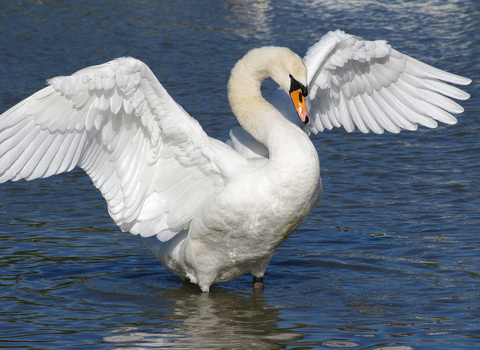
©Gillian Day
Mute swan
One of our most iconic waterbirds, the mute swan is famed for its grace and beauty. It is also considered to be a romantic of the bird world because partners form a perfect love heart with their necks.
Enw gwyddonol
Cygnus olorPryd i'w gweld
January to DecemberSpecies information
Category
Ystadegau
Length: 1.5mWingspan: 2.2m
Weight: 9-11.5kg
Average lifespan: 10 years
Classified in the UK as Green under the Birds of Conservation Concern 5: the Red List for Birds (2021). Protected in the UK under the Wildlife and Countryside Act, 1981.
Habitats
Ynghylch
The mute swan is one of the most familiar birds in the UK, its long, curved neck and graceful glide a regular sight on our waterways and waterbodies. Mute swans feed on plants, particularly waterweed. They usually mate for life, but some will have numerous partners.Sut i'w hadnabod
The only common swan in most places, the mute swan is easily recognised by its all-white body and its reddish-orange bill that has a large black 'knob' at the base.Dosbarthiad
Found throughout town and countryside, on canals, ponds, lakes and rivers across the UK.Roeddech chi yn gwybod?
A female swan is known as a 'pen' and a male is a 'cob'. Both males and females are involved in parenting; the cob will guard the nest while the pen leaves to feed, but will not incubate the eggs. Both parents are devoted to the cygnets, which, with their downy, brown fluff and short necks, do indeed look like the 'ugly duckling' of the rhyme! However, they soon grow into their adult plumage.Gwyliwch
Mute Swans (https://vimeo.com/447522584/0c611ac459)
Mute Swans by Tom Hibbert
